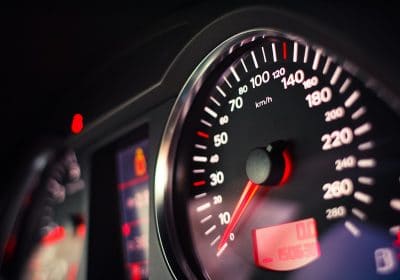What fluids do I need to check in my vehicle?
The six fluids you should check are Engine oil, Coolant (Antifreeze), Power steering fluid, Brake fluid, Transmission fluid (in an automatic transmission vehicle, not a manual), and Windshield washer fluid. Check these regularly to ensure proper vehicle function and longevity! Make a schedule and always watch out for unusual noises, odors, or vibrations.
What is the purpose of the fluids in my vehicle?
Keeping proper fluid levels play a huge part in almost every function of your car - including fuel economy and longevity. With engine components spinning thousands of reps per minute, it's the engine oil that keeps everything lubricated and smoothly in motion. Coolant (antifreeze) keeps the engine cool in the summer and protects it from freezing during the winter. Coolant also prevents corrosion, deposits, and foam from reducing cooling efficiency. Power steering fluid allows easy steering maneuverability (Anyone remember driving a classic car without power steering?!). Brake fluid connects the brake pedal to the brakes - when stepping on the pedal, a plunger pressurizes the fluid inside the brake lines, which cause the brake pads to clamp on the rotors, thus slowing the vehicle. Transmission fluid lubricates and cools transmission components (gears, clutches, and valves). Vital to safe driving, windshield washer fluid allows the driver to see clearly.
When is it best to check the fluid levels?
A good rule of thumb is to schedule an oil change every 3,000miles (5,000 if using synthetic oil) and check all the other fluids at the same time. If you schedule an oil change at Dowell Automotive, we will routinely check all fluids, tire pressure, and other general maintenance items while the vehicle is in the shop. But if you're checking them at home, start with your car, truck, or SUV parked on level ground and the engine cold. Checking the oil with a hot engine causes inaccuracy, and coolant can spray and cause burns if hot. Power steering and brake fluid can be checked whenever the vehicle is parked but should be monitored periodically. Transmission fluid has to be checked with the vehicle in park or neutral and the engine running to be accurate. Many transmissions come with a "lifetime" fluid that should never need replacement, but checking it periodically will ensure proper transmission function. Windshield washer fluid should be checked periodically, based on how often the driver uses it. If you frequently spray your windshield with washer fluid, checking the level when you fuel up your car would be an advised routine.
How to find and identify the fluids under the hood?
Once you have the vehicle's hood popped and securely propped open...
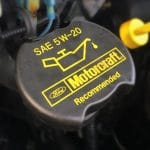 ENGINE OIL
ENGINE OIL
The engine oil dipstick will be located near the front of the engine of you have a front-wheel drive vehicle or located behind the engine if a rear-wheel drive vehicle. Most vehicles have a cap with an oil image or "engine oil" or type of oil listed in wording (see image to the left). First, pull the dipstick out and wipe it clean with a towel or rag. Then, reinsert the dipstick all the way and pull it back out again. You should be able to see oil on the stick. The dipstick has marked indicators for maximum ("full") and minimum ("add") level. Oil should be near the maximum line/area. Engine oil is yellow/amber color when new and brown/black when it's time for an oil change. If the oil has a burnt or gasoline odor, please schedule an appointment with us to look into engine issues further.
COOLANT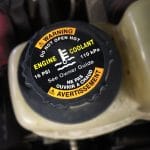
Find the radiator cap, usually with a symbol or "engine coolant" "antifreeze" wording (similar to the image on left), open it to see if the fluid level is filled up to the top. Coolant comes in a variety of colors depending on vehicle model age and manufacturer - blue, yellow, green, red, pink or purple. Never mix coolant types and always replace with the same type of antifreeze your vehicle's manual recommends. In an emergency (on a hot summer day), you can pour straight water into the coolant reservoir, until you get more coolant bought - water will freeze in the winter and doesn't offer corrosion, deposit, or foam prevention like antifreeze.
 POWER STEERING FLUID
POWER STEERING FLUID
Look for either a dipstick or reservoir cap in the engine bay with a label of power steering. Checking a dipstick for power steering fluid is similar to checking a dipstick for engine oil (see above). Power steering fluid is white wine/pinkish color.
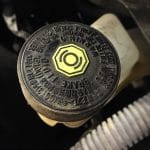 BRAKE FLUID
BRAKE FLUID
Locate the brake fluid cap, usually identified by brake fluid text or the similar (see image to left). Checking the brake fluid reservoir under the hood is as simple as taking the cap off and looking inside at the level and color. Brake fluid should be near the top and is an amber/white wine color.
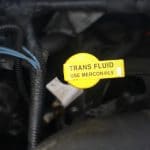 TRANSMISSION FLUID
TRANSMISSION FLUID
Some cars have a dipstick (like the left image), but others require a mechanic to inspect. If yours has a dipstick, the process to check is similar to engine oil but the engine needs to be running and the transmission in park or neutral depending on the manufacturer. It should be a translucent red/amber color.
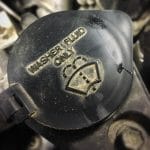 WINDSHIELD WASHER FLUID
WINDSHIELD WASHER FLUID
Usually blue, green, or orange/red in color, windshield washer fluid is one of the easiest (and most identifiable) under the hood. The cap usually has text or a symbol like the image to the left. If the fluid level isn't at or near the top, simply pour new washer fluid into the reservoir until it's full and close the cap. There are many brands and options of windshield washer fluid, but you might consider the type with a Rain-X additive for clearer windshield while driving in rain.
How to add fluids and when to change them?
We stock all fluids for every vehicle type, model and make. Fluids can also be purchased at your local auto supply store, gas station, or automotive department of your grocery store. Your vehicle's owner manual gives all fluid types and the amount needed for the specific vehicle. Synthetic engine oil can be substituted for traditional engine oil; it will cost a bit more per oil change but will last 5,000 miles instead of 3,000, so the cost per mile usually is about equal. Antifreeze should be changed every 2-3 years unless it's specifically formulated as "lifetime" coolant. An Antifreeze Tester will test coolant efficiency- if low, it should be replaced. When adding new/changing coolant, a 50-50 ratio of distilled water/coolant should be added. Power steering fluid should be check and topped off periodically; if low, adding more to ensure steering ease. If you notice brake fluid that is not translucent (cloudy or dark), replace it with a type compatible with your car. If the brake fluid falls below the minimum indicator without any external leaks it could be a sign to mechanical brake wear. Brake fluid is a sealed system and should never need to be toped off unless there is a leak To add transmission fluid, pour it into the fill tube if your vehicle has one. After verifying the level on the dipstick, move through the gears with your foot on the brake to help fluid flow through the transmission.
What happens if I run my vehicle with low fluids?
Running your vehicle with low or no fluids can be dangerous to you or anyone sharing the road with you. It can also result in costly repair bills, lower power and fuel economy, and may lead you to a decreased vehicle value. Driving an engine with low or no oil will cause engine damage. Low oil on the dipstick could indicate an engine leaking or burning oil, which will cause damage eventually. An engine with low coolant lowers efficiency and can result in engine overheating. If you allow the power steering reservoir to get low, the result will be difficult or no steering, which could cause an accident. Low brake fluid could mean water contaminated the lines and rusted them, causing a leak. Irregular brake pressure or no brakes means difficulty stopping and is a serious safety hazard to the driver and anyone on the road near the vehicle! Trans fluid that is low will cause rough shifting, strange noises, and uncontrolled surging, resulting in difficult driving. Difficulty seeing through the windshield if it gets dirty, bug smeared, or splashed with mud, can be dangerous. So make sure you have windshield washer fluid to clear your windshield.
__________________________________________
Dowell Automotive
If you suspect an issue while checking your vehicle fluids or are having any concerns on driveability, please contact us. Dowell Automotive would be happy to check and top off your Engine oil, Coolant, Power steering fluid, Brake fluid, Transmission fluid, and Windshield washer fluid.
To make an appointment give us a call at 765-477-0333 or visit us.


